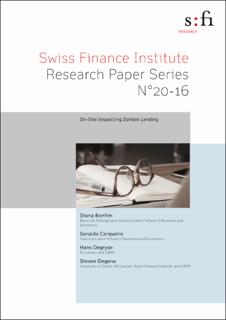| dc.contributor.author | Bonfim, Diana | |
| dc.contributor.author | Cerqueiro, Geraldo | |
| dc.contributor.author | Degryse, Hans | |
| dc.contributor.author | Ongena, Steven Roger G. | |
| dc.date.accessioned | 2023-01-30T13:49:35Z | |
| dc.date.available | 2023-01-30T13:49:35Z | |
| dc.date.created | 2022-10-24T06:38:53Z | |
| dc.date.issued | 2022 | |
| dc.identifier.issn | 0025-1909 | |
| dc.identifier.uri | https://hdl.handle.net/11250/3047189 | |
| dc.description.abstract | “Zombie lending” remains a widespread practice by banks around the world. In this paper, we exploit a series of large-scale on-site inspections made on the credit portfolios of several Portuguese banks to investigate how these inspections affect banks’ future lending decisions. We find that an inspected bank becomes 20% less likely to refinance zombie firms, immediately spurring their default. Overall, banks seemingly reduce zombie lending because the incentives to hold these loans disappear once they are forced to recognize losses. | en_US |
| dc.language.iso | eng | en_US |
| dc.publisher | INFORMS | en_US |
| dc.title | On-Site Inspecting Zombie Lending | en_US |
| dc.title.alternative | On-Site Inspecting Zombie Lending | en_US |
| dc.type | Peer reviewed | en_US |
| dc.type | Journal article | en_US |
| dc.description.version | acceptedVersion | en_US |
| dc.source.journal | Management science | en_US |
| dc.identifier.doi | https://doi.org/10.1287/mnsc.2022.4452 | |
| dc.identifier.cristin | 2064096 | |
| cristin.ispublished | true | |
| cristin.fulltext | postprint | |
| cristin.qualitycode | 2 | |
